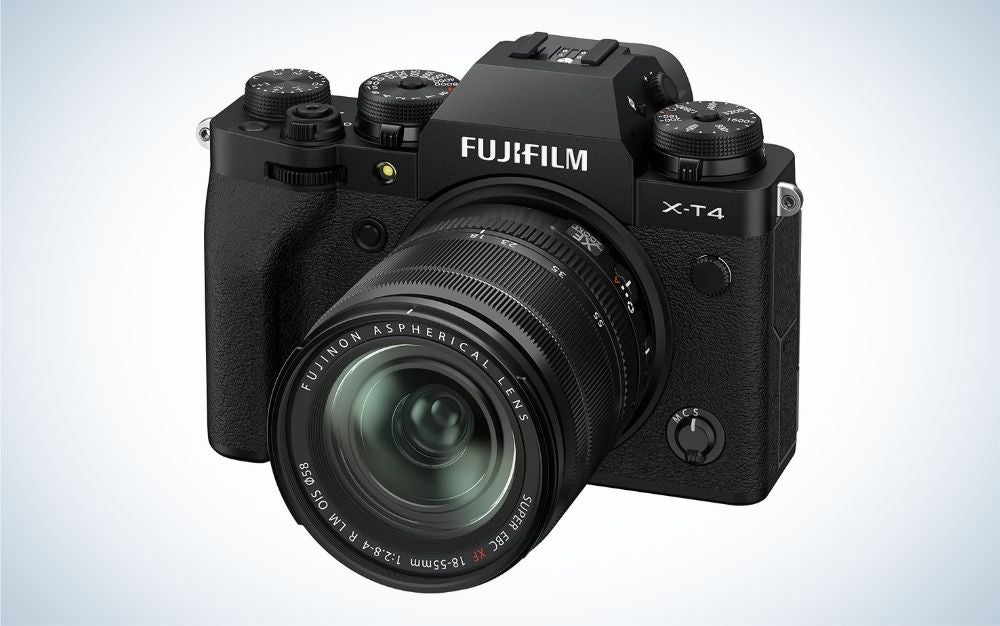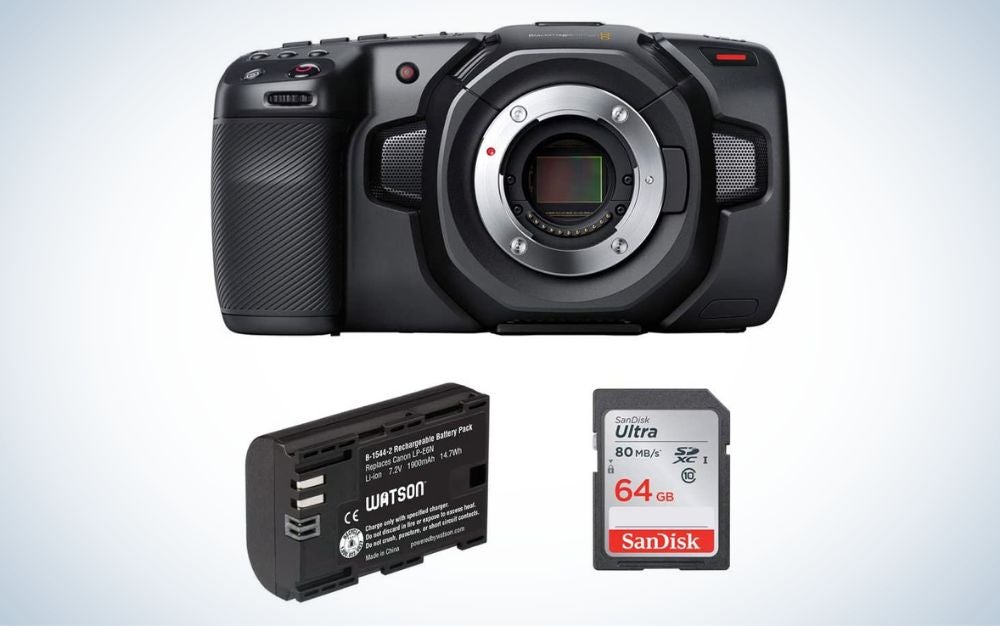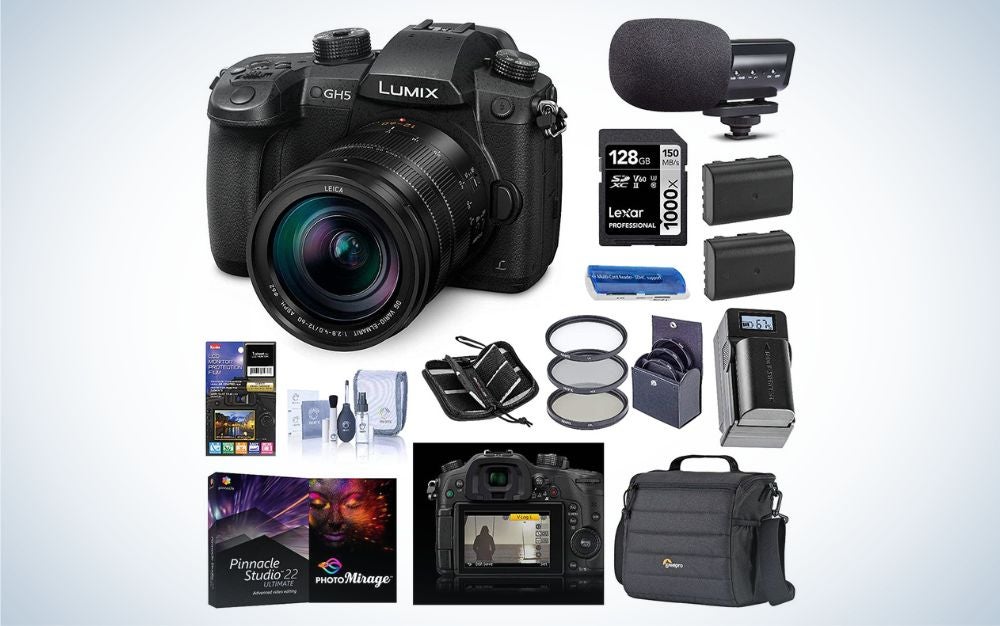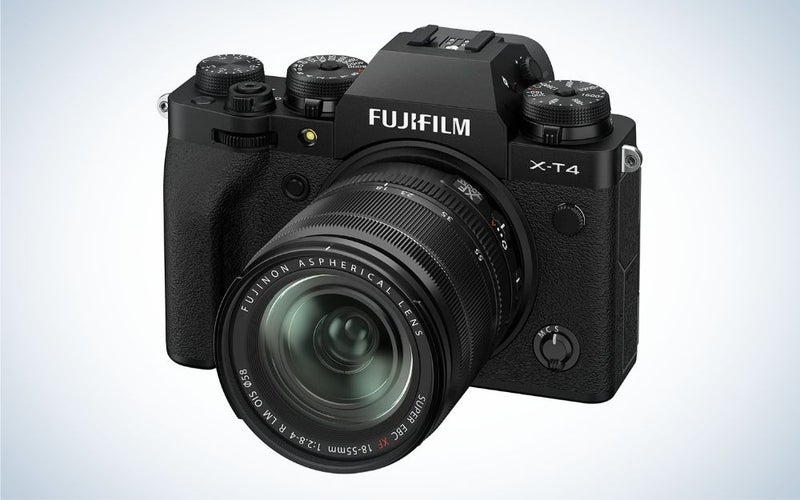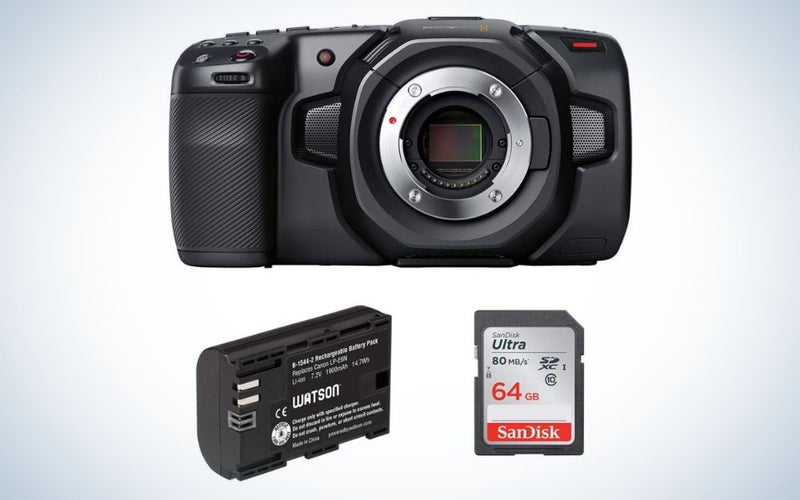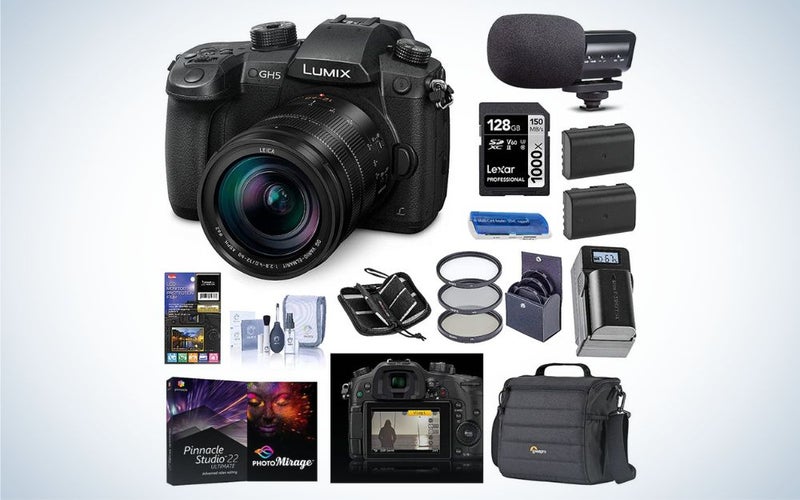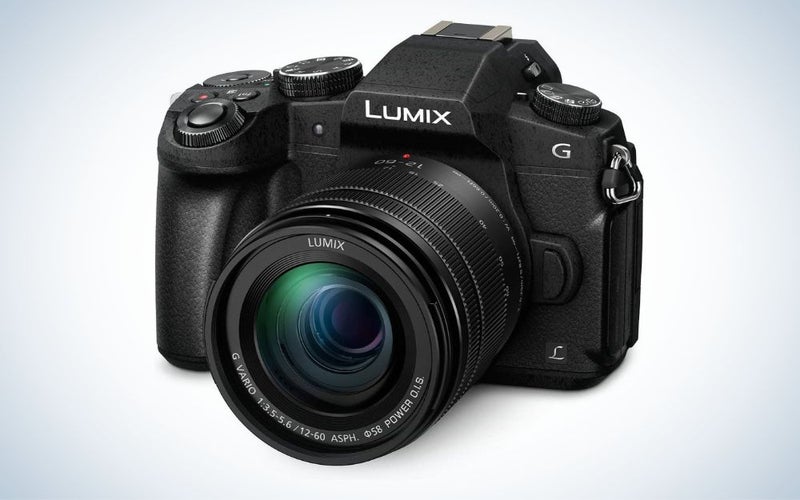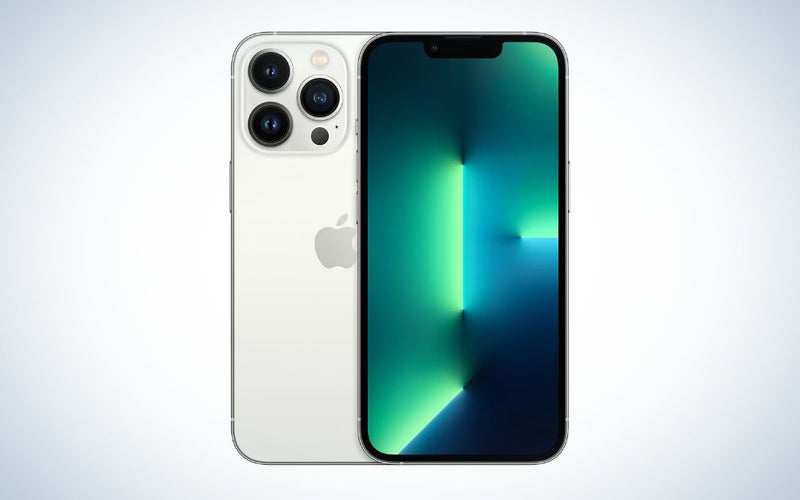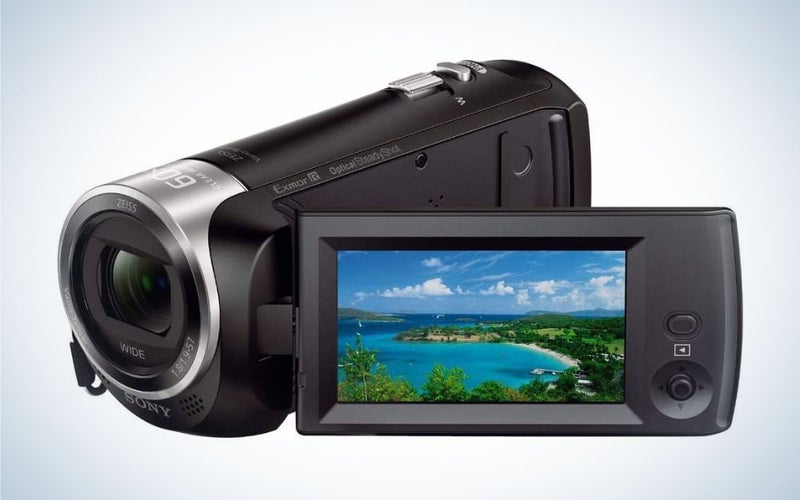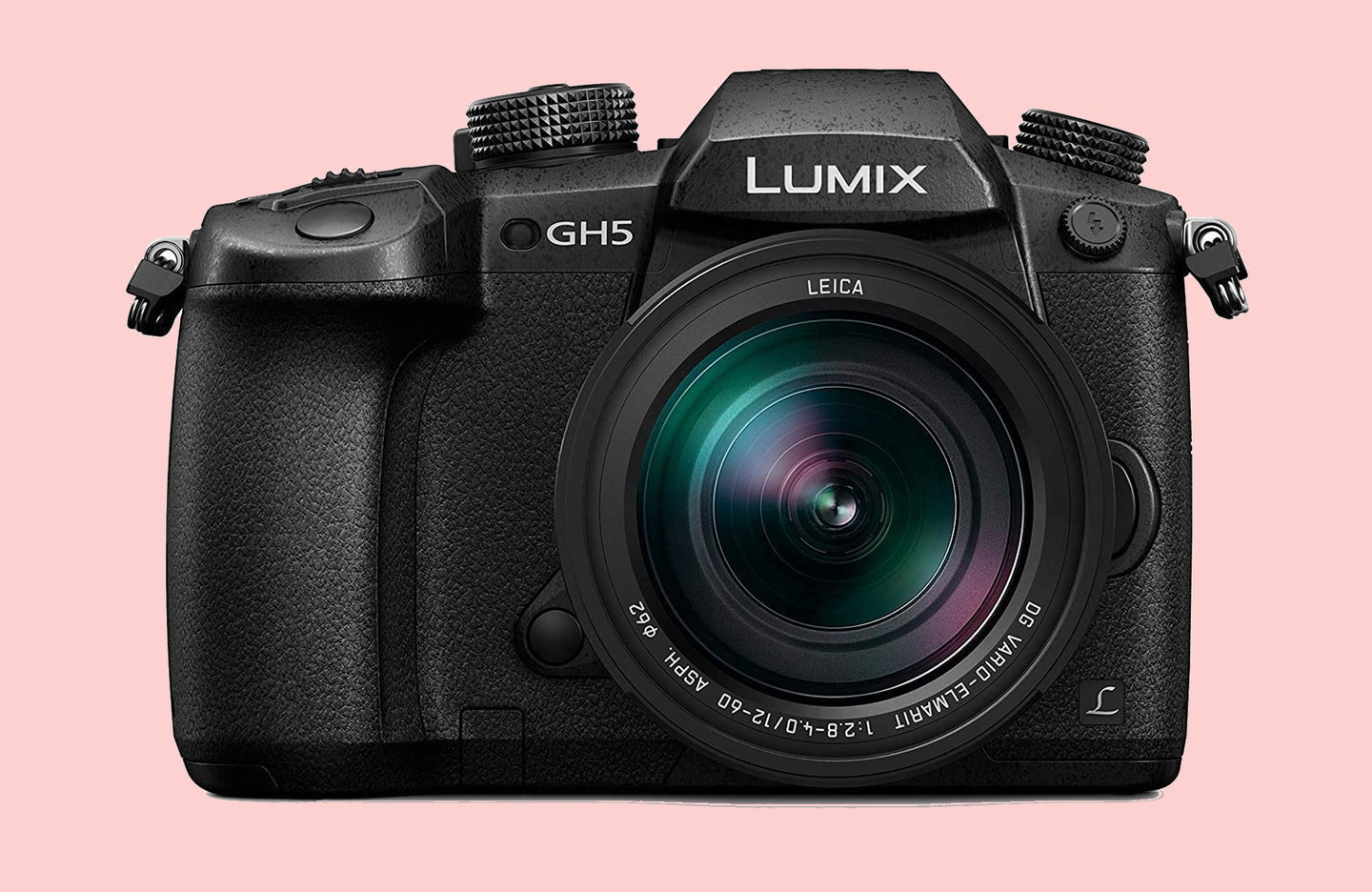
Recent years have provided some game-changing options when it comes to cameras for filmmakers on a budget. A camera should simply be a tool to help you tell that story, and you don’t necessarily need the highest end gear to get started. But, even relatively affordable gear can churn out high-quality results worthy of your creative vision. We’ve compiled this list of the best cameras for filmmaking on a budget to help bring those creative ideas to the screen.
- Best overall: Fujifilm X-T4
- Best cinema camera: Blackmagic Design Pocket Cinema Camera 4k
- Best Micro Four Thirds camera: Panasonic LUMIX GH5 4K
- Best budget 4K: Panasonic LUMIX G85
- Best smartphone for filmmaking: Apple iPhone 13 Pro
- Best budget HD camera: Sony HDR-CX405 HD Video Recording Handycam Camcorder
Things to Consider Before Buying a Camera for Filmmaking
A top of the line cinema camera (the kinds used by filmmakers in Hollywood) can cost upwards of $50,000, without accounting for the cost of the lenses and countless other accessories found on a professional set. Luckily you don’t actually need a super expensive camera to get started on your own film, in fact there are many low-cost options that will give you beautiful looking footage on a budget.
Lens mount
As with any system camera, you’re going to need lenses so the mount you choose matters. While the camera’s mount will determine which native lenses you can use, many filmmakers also rely on older glass attached with adapters. Since cinema work doesn’t typically require high-performance autofocus, old manual focus lenses can provide excellent image quality at lower prices than some modern options. Whatever you buy, make sure you know what your lens options will look like before you take the plunge.
Resolution
You’ll find that 4K is fairly standard at the moment, but it’s not always that cut-and-dry when it comes to resolution. Some cameras offer high-resolution footage or over-sampled 4K, which employs more pixels in order to capture a more detailed 4K image. Some filmmakers prefer higher-res footage because it allows them to crop slightly or apply image stabilization in editing with help from that extra image area around the frame.
Typically, as resolution goes up, the frame rates at which you can shoot come down. If you want to shoot silky 120 fps slow motion at 4K, expect to shell out more money for a camera than if you can compromise in either one of those areas.
Video formats
If you’re just planning to shoot standard video modes to built-in memory cards, then you won’t have to worry too much about the more advanced video formats. Once you start moving on to more elaborate productions, however, log and raw capture become more important.
Some cameras output raw video data, which is simply data from the sensor that needs conversion before you can edit or view it. Raw footage doesn’t reflect things like color balance and other variables you typically worry about when shooting. This kind of footage is laborious to work with and edit, but it often provides the best possible raw material to work with during the editing process.
Log recording achieves a similar purpose in that it attempts to maximize the amount of dynamic range in footage from the sensor. Unlike raw, however, log (in its various flavors) is actually a video format so the footage will look extremely flat, but it will reflect variables like color balance and it doesn’t need conversion before you can view or work with it.
We can’t get into the nitty gritty details of it all here, but it’s worth taking some time to read about these formats and understand their usage before you decide whether or not you plan to shoot with them.
Hybrid shooting
If you’re buying a camera that can shoot both video and stills, make sure you know what kind of compromise that involves. The Canon R5, for instance, has immaculate video specs, but it’s a hybrid camera without built-in cooling, so it limits your overall recording time in some situations.
The best cameras for filmmaking on a budget in 2022: Picks and reviews
Best overall: Fujifilm X-T4
Fujifilm
Why It Made The Cut: The Fujifilm X-T4 is a hybrid mirrorless camera with excellent in-body image stabilization and impressive 10-bit 4K video capabilities—a reasonable tool for a beginning filmmaker who is also in need of a stills camera.
Specs
- 26 megapixel CMOS APS-C sensor
- 10-bit 4K video capabilities
- 160-12800 (expandable to 80-51200) ISO range
Pros
- In body image stabilization
- 10-bit 4K capture
- Film simulation modes
- Vari-angle touchscreen
Cons
- No headphone jack for monitoring audio
The Fujifilm X-T4 is a lightweight mirrorless camera with fantastic in-body image stabilization and 10-bit 4K capabilities that make it an excellent tool for novice filmmakers looking for a camera that can shoot video and stills. It can shoot 4K at 60fps, full HD at 240fps for slow-motion footage and can record for about 30 minutes at a time. Autofocus can still track faces while recording making it a great tool for filming interviews. It features a number of attractive film simulation modes, including the new ETERNA Bleach Bypass, for beautiful de-saturated, high-contrast footage.
It’s also a great hybrid shooting camera that will capture excellent stills as well. Plus, Fujifilm cameras work very well with an abundance of cheap adapters for vintage lenses, which really opens up affordable glass options.
Best cinema camera: Blackmagic Design Pocket Cinema Camera 4k
Blackmagic Design
Why it made the cut: This camera won’t actually fit in your pocket, but it does offer an impressive array of features for a very surprisingly low price.
Specs
- Micro Four Thirds sensor
- 4k at up to 60 fps
- ISO range up to 25,600
Pros
- Roomy 5-inch touchscreen
- HDR shooting
- Lots of advanced video formats including raw
- Easily adapts other lenses
Cons
- It’s a dedicated cinema camera so not great for stills
Blackmagic has made a ton of noise in the budget filmmaking world with its cameras that regularly over perform their price tags. This compact camera sports a 4/3 image sensor with a Micro Four Thirds mount in front of it. It shoots a wide variety of high-end formats, including Blackmagic’s own format, which maximizes detail and dynamic range while making workflow feel like typical video.
The back of the camera sports a five-inch touchscreen that grants access to an array of advanced features. From a hardware standpoint, it provides a full array of connections, including several types of microphone jacks and, of course, a headphone jack for monitor audio. Built-in Bluetooth allows for remote camera control via iPad or smartphone.
When it comes to pure cinema cameras on a budget, this little body is hard to beat. If you have more budget at your disposal, you can step up to the 6K version, which includes a bigger sensor and an EF lens mount option.
Best Micro Four Thirds camera: Panasonic LUMIX GH5 4K
Panasonic
Why It Made The Cut: The Panasonic GH5 can shoot 10-bit 4K at 60 fps and has V-Log L gamut built in—making it one of the most appealing 4K cameras on the market. This particular version is packaged as a kit and includes useful accessories like ND filters and a microphone to get you started.
Specs
- 20.3MP Digital Live CMOS sensor
- 10-bit 4K video capabilities
- 200-25600 (expandable to 100-25600) ISO range
Pros
- Excellent image stabilization
- Affordable 4K camera
- Built-in V-Log, Cinelike gammas and downloadable LUTs
Cons
- Autofocus struggles despite updates
The Panasonic GH5 is a powerful micro four thirds camera with 4K capabilities and excellent color reproduction. It has unlimited recording time, anamorphic capture up to 4K at 50 fps, and built-in Cinelike gammas that will give you beautiful looking footage without having to do any color grading.
It supports vertical video (a great tool for social shooters), resizable waveforms, and an updated info display that makes monitoring your settings while shooting a breeze.
While the sensor is relatively small, this camera captures footage at very high bitrates and has access to a huge library of Micro Four Thirds glass. It’s also light and compact, which makes it a great option for run-and-gun shooting.
Best budget 4K: Panasonic LUMIX G85
Panasonic
Why It Made The Cut: A low-cost, lightweight 4K capable camera, Panasonic’s G85 is an appealing option for novice filmmakers looking to spend less than 1K on a camera.
Specs
- 16 megapixel Live CMOS sensor
- 5-axis in-body image stabilization
- 4K video capabilities
Pros
- 5-axis in-body image stabilization
- Fully-articulating LCD
- Budget friendly 4K camera
Cons
- No headphone input for monitoring audio
- Mic and HDMI ports limit LCDs movement when in use
The Panasonic G85 has an articulating touch display, a 2.36M dot OLED electronic viewfinder and 5-axis in-body image stabilization. When compared to other 4K capable cameras it’s also an extremely affordable choice—in part because it’s an older camera, with a smaller sensor that lacks some of the higher-end features found in cameras released more recently. Despite this, the G85 is a perfectly capable camera for a filmmaker on a budget. That small price comes in very handy when you’re also buying essential filmmaking accessories like an external recorder or a cage.
Best smartphone for filmmaking: Apple iPhone 13 Pro
Apple
Why It Made The Cut: The best camera is the one that’s with you, and the most recent iPhone has a number of features that will appeal to filmmakers—although the phone itself isn’t necessarily low budget, the fact that it can double as your primary communication device is why it made the cut.
Specs
- 4K up to 60fps
- A15 Bionic chip
- Three 12-megapixel camera lenses
Pros
- Telephoto, wide and ultra wide lenses
- Cinematic mode
- Advanced low light shooting mode
Cons
- Large and heavy, not great for shooting handheld for a long time
Apple’s new flagship iPhone has a bright OLED screen, three 12 megapixel cameras, an updated A15 Bionic chip for processing, advanced video modes and the ability to shoot 4K footage. And since it’s a smartphone it’s a piece of tech that most video creatives will already have on-hand. If you are planning to use it to shoot a feature-length film you will absolutely need to consider external storage and you will probably be most comfortable using the phone on a gimbal or tripod—but there’s a lot to love about this pocket-sized camera. Advanced features like Cinematic Mode, Advanced Low Light Video and the Optical Zoom make it a particularly appealing tool. If you’re using it to film something we’d just recommend turning off your notifications so you can stay focused on framing up your shots.
Best budget HD camera: Sony HDR-CX405 HD Video Recording Handycam Camcorder
Sony
Why It Made The Cut: The Sony HDR-CX405 Handycam is an extremely budget friendly camera to get started with filmmaking, although it lacks some of the high-end settings of other cameras in this buying guide, you simply can’t beat the price.
Specs
- Exmor R CMOS sensor
- 1080p video capabilities
- Zeiss 30x optical zoom lens
Pros
- Truly budget friendly
- Easy to use
- Features face detection
Cons
- No 4K option
The Sony Handycam is an extremely budget-friendly tool for the novice filmmaker. It can shoot 1080p at 60 fps, features in-body stabilization, 30x optical zoom and face detection. The LCD screen flips out, and it has a comfortable hand grip for shooting handheld footage. This particular model comes bundled with a tripod and lens cleaning kit so you can start shooting as soon as it arrives.
FAQs
Q: Which camera is best for video shooting on a low budget?
Low budget means something a little different for everyone, but you absolutely don’t need the newest, high-end camera to get started with a low-budget video project. Before purchasing a camera for filmmaking you should consider what other types of projects the camera might be useful for. If you are a filmmaker who also does photography a slightly more expensive mirrorless camera might be the way to go because you will be able to use it for photography as well as filming.
Q: How much does a camera for filmmaking on a budget cost?
The cost of cameras can range anywhere from a few hundred dollars to a few thousand. Price will largely depend on a camera’s ability to shoot 4K footage, sensor size, and advanced recording capabilities. If you are hoping to make a film that might one day end up on a streaming platform it makes sense to get something that can shoot 4K, but if you are primarily making pieces that will be uploaded to platforms like YouTube a camera that shoots in 1080 should be plenty.
Q: What is the most affordable cinema camera?
The BlackMagic Design Pocket Cinema Camera 4K is one of the most adorable cinema cameras currently on the market at $1300, but that’s for body only. Cinema lenses are where you will really spend your money, but ultimately the lens that you are using affects the overall aesthetic of the footage you are shooting more than a camera body would.
Q: What camera for filmmaking do Youtubers use?
YouTubers use a wide variety of cameras for creating content with many of them favoring the cameras of their sponsors. If you follow YouTubers who are covering filmmaking or photography on their channel you will probably only have to watch a few episodes to learn what gear they are using to create their content.
Q: Are DSLR cameras good for filmmaking?
If a DSLR is the camera that you have access to and it has video recording capabilities it will absolutely work for filmmaking. For many years Canon’s line of 5D cameras were the preferred tool of video journalists making content for the web.
Q: Which camera is best for filmmaking?
Best is entirely dependent on what your goals are, what your budget is and ultimately will vary widely between filmmakers. What might be the best camera for one filmmaker will be a horrible choice for another.
Q: Which is better for filmmaking, DSLR or mirrorless?
A DSLR or a mirrorless camera can both be used for filmmaking, although these days many videographers who aren’t using a cinema camera prefer working with a mirrorless camera because of their smaller body size and advanced autofocus features.
Final Thoughts
Ultimately you don’t need the highest end, most expensive camera to get started with filmmaking. The most important thing is the story and a camera is simply a tool that will help you tell that story. Also, before you splurge on a camera outside of your budget, remember that renting gear is always an option and an easy low-cost way to get your hands on high-end equipment without breaking the bank.
Methodology
When selecting the products for this buying guide the most important thing that we considered was budget. Low-budget can mean very different things to different styles of filmmakers, but we wanted to showcase cameras that were under 3,000 dollars. It was important to select cameras that had 4K filming capabilities, image stabilization but that were also user friendly. The cameras that are featured in this guide were selected through a mixture of hands-on-experience, user feedback, and editorial reviews.
The post Best cameras for filmmaking on a budget in 2022 appeared first on Popular Photography.
